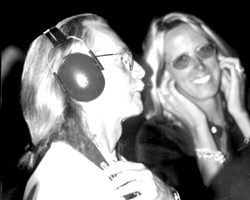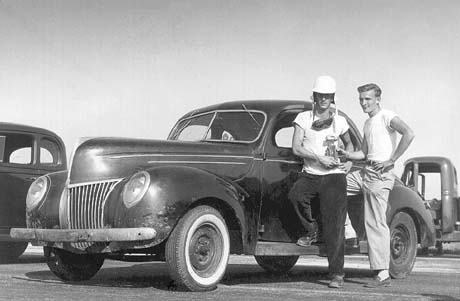| | | ||||
 | |||||
 Note to Reader: Please assume that all statements below are accompanied by the disclaimer, “I think this is the way it happened.” After all, we’re talking about events that took place at just about the same time John Force gurgled, burped, pushed up from all fours onto two feet for the first time, tottered precariously, then bellowed, “Get me Fedderly and Coil... I ain’t too sure how things work from here on...” Note to Reader: Please assume that all statements below are accompanied by the disclaimer, “I think this is the way it happened.” After all, we’re talking about events that took place at just about the same time John Force gurgled, burped, pushed up from all fours onto two feet for the first time, tottered precariously, then bellowed, “Get me Fedderly and Coil... I ain’t too sure how things work from here on...” First time at the drags? As I mentioned in my first column here (Vol.1, No.1), that would have to be Hagerstown, Maryland, in 1951, in company with cohorts from the (Washington) D.C. Dragons Hot Rod Club, a charter club in the then-newborn National Hot Rod Association. I know Larry Hickey and Joe Granducci, and probably Gene Aldous, were hooked up to the 75-mile train of derring-do drivers who made the sojourn from the Washington area to what then was the far-far planet of Hagerstown, but I can’t really recall specifically who else. In fact, I’m hoping that some of ‘em out there will remind me that they were aboard too! I do remember that it was in the summer and that we all had our “air conditioners” on (read: the windows were down). The Dragons were formed in 1950, about the same time the Silver Spring (Maryland) Ram Rods and Arlington (Virginia) Road Knights, situated in the northern and southern suburbs of the general D.C., area, respectively, were born. The ranks of these clubs included then and continued to provide a number of members who later went on to note and/or infamy, including several who journeyed to the West Coast and who have contributed more than their share to automotive and racing history. Fred Gregory (journalist), Bill Moeller (car show productions), Jim Davis (company executive and ad agency head), Doug Kruse (aluminum-body builder, inventor, and drag racing promoter) and Fred Muelenhort (race car chassis builder) are names that come immediately to mind. (There are many others, I’m sure, and I hope to further research this intercoastal phenomenon in the future.) I made the Left Coast commitment myself in 1967 and spent most of the next 32 years there. Through the years, the three clubs developed great racing rivalries and bench-racing-and-beer-fests, and also jointly promoted and participated in activities beneficial to their respective communities, such as clothing drives and blood donating; there were undoubtedly some racers who were or would become members of the Ram Rods and Road Knights who also hit the highway to Hagerstown.
Granducci was the President of the Dragons then, a jet pilot during the time of the Korean “police action,” owner of a great baritone voice that could be stentorian when required to keep us in line, and a ‘50 Chevy 6-banger, 2-door slope-back sedan that was faster than snot! As I recall, it was the only Chevy in the club at the time, but it made believers out of a lot of us who could only spell F-O-R-D up till then. Our meetings were held at Granducci’s parents’ house, at the top of a long hill that wound up from Massachusetts Avenue in the fashionable northwest section of the D.C. area. Usually, just before time for our weekly meetings, most of the club members were gathered in and around the Granducci driveway and garage area, waiting for Joe. He was never late, but his daily routine usually kept him until just before meeting time; we always knew when he was close, though, because the sound emanating from that split-manifold-equipped, heavily-modified Chevy wound up through the woods below and transfixed us with its loud crackle, higher pitched than any of the Fords’ exhausts, growing to a crescendo as Joe turned, knowingly smiling, into the driveway, alit, and called the meeting to order. Aldous had a ‘32 3-window Ford coupe into which he eventually stuffed an Olds Rocket 88 engine. I believe Gene was the only Dragon at the time who was employed full-time as a mechanic. He was physically imposing and could have been pretty scary had it not been for his extreme good nature, which we took advantage of by asking every automotive question we had not been able to answer otherwise during the six days leading up to that week’s meeting. Gene often looked amused at some of the inane queries we came up with, but he always answered every question he knew the answer to. That’s how the hot rod club system worked then, every member contributing what knowledge he or she had. I was not then nor am I now especially naturally mechanically inclined, but I had learned something of the workings of the English language, so I was called upon to write letters and create propaganda for the growing hot rod movement that drove our clan. These endeavors eventually included, after having moved our meeting place to a courtroom in the Bethesda, Maryland, police station when our numbers grew too large for the Granducci living room, presenting plans for the development of a drag strip and its administration to the Montgomery County Council. The Dragons’ efforts in that direction were well received, but ultimately rejected at the time. We liked to believe, however, that our pioneering push helped break new ground politically and socially in the area, and provided a foundation from which eventually sprang 75-80 Drag-A-Way, opened in 1960 by Bill Wilcom in Monrovia, just across the Montgomery County line in Frederick County, still running strong at last report. Anyway, specifically, I don’t remember how many cars competed at that extraordinary ‘51 race, but somewhere around 30 cars, I judge in extreme hindsight. And, yes, it was held on the backstretch of the Hagerstown Raceway 1/2-mile dirt oval, meaning that not only were we draggin’ on dirt, but on banked dirt! Talk about “handicap” racing! I was then the extremely proud owner of a ‘41 Ford business coupe, whose engine compartment contained a mildly souped — even by Fifties standards — stock bore and stroke flathead engine. It wore a dual exhaust kit (my first mechanical achievement!) equipped with Smitty steel pack mufflers whose here-comes-a-thunderstorm! rumble was further enhanced with penny-blocked heat risers. The heads were finned aluminum Offenhausers, and the manifold was a three-Stromberg-97-carb, polished Edmund’s affair. Firing was through a Mallory point-and-coil setup. The internals were all stock, but a 3/4-Harmon & Collins cam was installed a little later, at the side of Hickey, who patiently tutored me on what happened between the time I filled my gas tank and the moment the spent exhaust poured from the chrome tips of the pipes that snaked beneath the chassis. That, indeed, is how I learned the “other” critical facts of adolescent life: by Hickey’s taking me and a 59A flathead engine into his workroom and literally wrenching it apart and putting it back together bolt by bolt, explaining the relationship of each piece to the next until the job was complete. As I alluded to above, I’m real average when it comes to mechanical perception and application, but the lessons from Larry helped me understand once and for all the basic relationships among the cam, crank, rod, piston, induction, compression, power, exhaust, ignition and related modules in an internal combustion engine. Hickey, whom we lost to cancer way too soon a few years ago, was a true pioneer in eastern states drag racing, producing what may have been the first fuel dragster in the Mid-Atlantic region. He was also my high school chum and runnin’ mate at the time, and he showed me what I could not glean from books, seemingly no matter how basic. I am grateful to him to this day for those lessons, the opportunity a little later on to drive some of the race cars he built, and the friendship we shared. There, in Hagerstown, as I struggled to get my pride and joy race ready, he was also on hand to mentor me on the use of Octagon soap and bailing wire as a leak sealer and stabilizer for the fuel lines that had rattled loose on the way to the race (not real high-tech, but effective enough to allow me to compete and still make it home that night!). As for the results of that antediluvian endeavor, I recall that I won my first round match, but lost the next. (That damn inside lane! How the hell you ‘sposed to get traction when you’re already slippin’ sideways?! – ‘Course I did have the outside, less canted lane in the opener...) The rest of the results are not even a vague mist as I write this, but I do know that the pure joy and elation I gained by driving to, tuning my ‘41 as best I could for, and competing in this event further cemented racing in my psyche as a facet of life that still excites me to this moment, a love that had begun a couple of years earlier at Cox Esso station in Bethesda. More about that later.
John Raffa is currently freelancing in Huron, Ohio,
photo by Jeff Burk
| |||||
|
Copyright 1999-2001, Drag Racing Online and Racing Net Source | |||||

